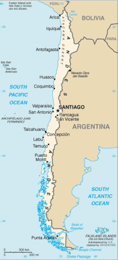September 28th, 2018

General Country Facts:
1. Located in Southern South America, bordering the South Pacific Ocean, between Argentina and Peru

2. slightly smaller than twice the size of Montana
3. It has a population of 17,789,267 (July 2017 est.)
4. It’s capital is Santiago while Valparaiso is the seat of the national legislature
5. It commits 4.9% of GDP to education (2015), 90th in world ranking
6. 97.5% literacy amongst the ages of 15 and above
7. The government is a Presidential Republic
Overview of the Education System:
8. 12-year guaranteed free mandatory education (based on May 2003 reform to the Chilean Constitution)
9. The following undergraduate degree programs are offered: Técnico (Technician); Títulos Profesionales (Professional Titles) ; Bacherillato/Bachiller (Bachelor); and Licenciatura/Licenciado (Licentiate).
10. The Ministry of Education (Ministerio de Educación) regulates all levels of education and its Consejo Nacional de Educación approves and monitors institutions of higher education.
11. The Consejo Nacional de Educación monitors a new institution and its programs for a period of six years. If the institution’s performance is satisfactory it is granted autonomy (institución autónoma). If not, the institution may be placed on a five-year probationary period or be forced to close.
12. Under the umbrella of the Consejo Nacional de Educación, there are two national accreditation commissions: the Comisión Nacional de Acreditación (CNA) which accredits institutions and programs at the undergraduate level and the Comisión Nacional de Acreditación de la Calidad de Programas de Postgrado (CONAP) which accredits institutions and their programs at the graduate level.
13. Institutional accreditation began in 2003 and is voluntary.
14. The Ministry of Education oversees and monitors vocational education.
15. Spanish is the official language of instruction.
Elementary and Secondary Education:
16. Elementary Cycle (Educación Básica) – 8-year elementary cycle (aged 6-13) leads to Licencia de Educación Básica, and consists of 2 phases:
i) primer ciclo básico (initial phase) [grades 1-4], 4 years in duration for ages 6-9;
ii) Segundo ciclo básico [grades 5-8], 4 years in duration for ages 10-13.

17. Secondary Cycle (Educación Média) – 4 years and divided into two 2-year cycles:
i) first 2 years consist of a common core curriculum
ii) last 2 years depend on the track selected (enseñanza média humanistico- cientifica/general secondary education, enseñanza média técnico-profesional/ technical vocational education, enseñanza artistica/art education).
18. Secondary education (educación secundaria or educación/enseñanza média) is offered at either a liceo, colegio or institution. Completion of secondary cycle lead to a Licencia de Educación Media or Licencia de Enseñanza Media which provide access to university education.

Higher Education (Educación Superior):
19. Admission to first year of university studies requires the Licencia de Educación Media or Licencia de Enseñanza Media (secondary school diploma).
20. Since late 2003, a new entrance examination known as Prueba de Selección Universitaria (PSU) has been instated and applied by all universities affiliated with the Consejo de Recotres de las Universidades Chilenas (CRUCH)
21. There are 3 types of institutions at the higher education level: Universidades (universities); Institutos Profesionales (professional institutes); Centros de Formación Técnica (technical training centers)
22. Universities have the right to award academic degrees such as Licenciado (Licentiate/ Undergraduate degree), Magister (Master/Graduate Degree), and Doctor (Doctorate) as well as the right to award qualifications intended for professional licenses.
23. Centros de Formación Técnica (technical training centers) and Institutos Profesionales (professional institutes) provide 2-3-year vocational education programs known as carerras técnicas de nivel superior, leading to the Técnico de Nivel Superior (Advanced Level Technician) certificate or Titulo Profesional, respectively.
24. Undergraduate University Education (Pregrado) – requires the secondary school diploma and entrance examinations for admission, offering programs of 4-5 years in length leading to the Licenciado degree in a field of specialization, or a Titulo Profesional (professional qualification), such as Ingeniero (Engineer) or Enfermero (Nurse). Some universities may offer a two-year program leading to the Bachiller which is an intermediate certificate and gives access to the Licenciado degree once an additional two year have been completed.
25. Graduate (Posgrado) – Requires the Licenciado or Titulo Profesional for admission. Direct entry to Doctorado program from Licenciado is possible, but the duration of studies will be longer.
26. Posgrado programs are as follow:
i) Postitulo (Post Degree), 1 year minimum in duration, focused on further specialization in a specific field/discipline but may not require a thesis;
ii) Magister, 1-2 years, and may require either a thesis (tesis de grado)or graduation assignment (trabajo final);
iii) Doctorado (Doctorate), highest academic qualification and requires a Licenciado or Magister degree for admission, and awarded after 3-5 years of study that includes research and successful defense of the doctoral thesis.
More facts:
27. Over last 20 years Chilean higher education has changed drastically, experiencing a boom in enrollments. In 2011, seven out of ten students were the first generation from their family accessing university. From 1990 to 2011 the gross higher education enrollment ratio increased from 14 percent to over 50 percent. Total enrollments have increased from about 660,000 in 2005 to almost 1.2 million today. (Click here for source)
28. There are 43 accredited universities, 19 accredited professional institutes, and 18 accredited technical institutions (by December 2015, according to the information from www.cnachile.cl), all of which contribute to a total of approximately 1,160,000 students in the Chilean educational system (44% in universities). (Source: EducationUSA)
29. The major institution is the University of Chile (originally founded in 1738), with campuses in Santiago, Arica, Talca, and Temuco.

30. The University of Santiago of Chile and the Federico Santa María Technical University, in Valparaíso, are technical universities patterned after the German model.
31. Private universities are the Catholic University of Chile in Santiago, the Catholic University of Valparaíso, the University of the North in Antofagasta, the University of Concepción, and the Southern University of Chile in Valdivia.
Bonus Fun facts:
32. Literature, poetry in particular, is the most significant of the creative arts in Chile. Two Chilean poets, Gabriela Mistral and Pablo Neruda, won the Nobel Prize for Literature (1945 and 1971, respectively), and the poetry of Vicente Huidobro and Nicanor Parra, also of the 20th century, is recognized in the world of Hispanic literature. In the late 20th century the novels of Isabel Allende became highly acclaimed not only in Latin America but also, in translation, in Europe and North America. (Source: Britannica)
33. Chile is one of the few countries on earth that has a government-supported UFO research organization. (Source: International Business Times)
Key Contacts
Chilean Ministry of Education
EducationUSA
Fulbright Commission Chile
National Accreditation Commission Chile
National Council on Education
Sources:
https://www.cia.gov/library/publications/resources/the-world-factbook/
https://wws.princeton.edu/sites/default/files/content/Chile%20Workshop%20Report_HigherEd%203.15.pdf
https://www.britannica.com/place/Chile/Education
https://www.educationusa.cl/educational-system-in-chile/
https://www.factretriever.com/chile-facts
The Academic Credentials Evaluation Institute, Inc. (ACEI), was founded in 1994 and is based in Los Angeles, CA, USA. ACEI provides a number of services that include evaluations of international academic credentials for U.S. educational equivalence, translation, verification, and professional training programs. ACEI is a Charter and Endorsed Member of the Association of International Credential Evaluators. For more information, visit www.acei-global.org.


















